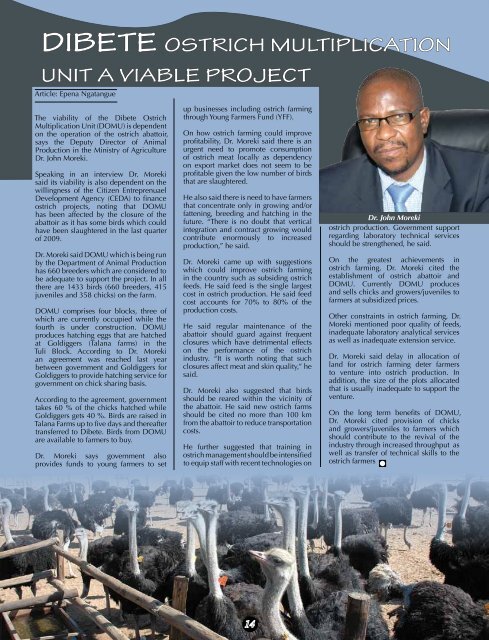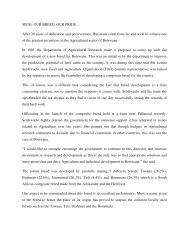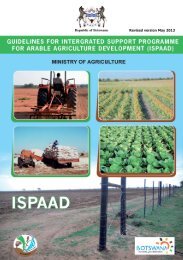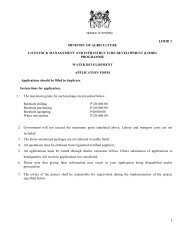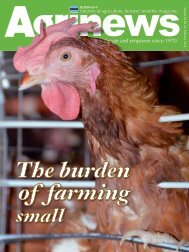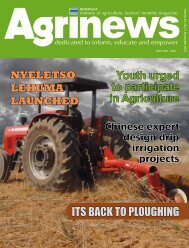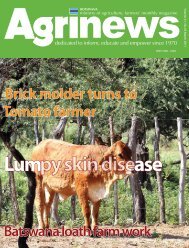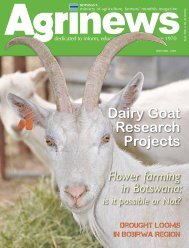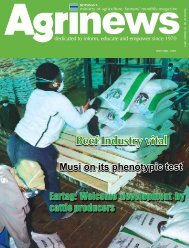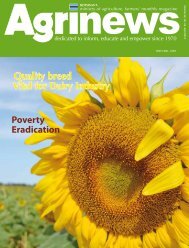Botswana's karakul renaissance - Ministry of Agriculture
Botswana's karakul renaissance - Ministry of Agriculture
Botswana's karakul renaissance - Ministry of Agriculture
Create successful ePaper yourself
Turn your PDF publications into a flip-book with our unique Google optimized e-Paper software.
DIBETE OSTRICH MULTIPLICATION<br />
UNIT A VIABLE PROJECT<br />
Article: Epena Ngatangue<br />
The viability <strong>of</strong> the Dibete Ostrich<br />
Multiplication Unit (DOMU) is dependent<br />
on the operation <strong>of</strong> the ostrich abattoir,<br />
says the Deputy Director <strong>of</strong> Animal<br />
Production in the <strong>Ministry</strong> <strong>of</strong> <strong>Agriculture</strong><br />
Dr. John Moreki.<br />
Speaking in an interview Dr. Moreki<br />
said its viability is also dependent on the<br />
willingness <strong>of</strong> the Citizen Entreprenuael<br />
Development Agency (CEDA) to finance<br />
ostrich projects, noting that DOMU<br />
has been affected by the closure <strong>of</strong> the<br />
abattoir as it has some birds which could<br />
have been slaughtered in the last quarter<br />
<strong>of</strong> 2009.<br />
Dr. Moreki said DOMU which is being run<br />
by the Department <strong>of</strong> Animal Production<br />
has 660 breeders which are considered to<br />
be adequate to support the project. In all<br />
there are 1433 birds (660 breeders, 415<br />
juveniles and 358 chicks) on the farm.<br />
DOMU comprises four blocks, three <strong>of</strong><br />
which are currently occupied while the<br />
fourth is under construction. DOMU<br />
produces hatching eggs that are hatched<br />
at Goldiggers (Talana farms) in the<br />
Tuli Block. According to Dr. Moreki<br />
an agreement was reached last year<br />
between government and Goldiggers for<br />
Goldiggers to provide hatching service for<br />
government on chick sharing basis.<br />
According to the agreement, government<br />
takes 60 % <strong>of</strong> the chicks hatched while<br />
Goldiggers gets 40 %. Birds are raised in<br />
Talana Farms up to five days and thereafter<br />
transferred to Dibete. Birds from DOMU<br />
are available to farmers to buy.<br />
Dr. Moreki says government also<br />
provides funds to young farmers to set<br />
up businesses including ostrich farming<br />
through Young Farmers Fund (YFF).<br />
On how ostrich farming could improve<br />
pr<strong>of</strong>itability, Dr. Moreki said there is an<br />
urgent need to promote consumption<br />
<strong>of</strong> ostrich meat locally as dependency<br />
on export market does not seem to be<br />
pr<strong>of</strong>itable given the low number <strong>of</strong> birds<br />
that are slaughtered.<br />
He also said there is need to have farmers<br />
that concentrate only in growing and/or<br />
fattening, breeding and hatching in the<br />
future. “There is no doubt that vertical<br />
integration and contract growing would<br />
contribute enormously to increased<br />
production,” he said.<br />
Dr. Moreki came up with suggestions<br />
which could improve ostrich farming<br />
in the country such as subsiding ostrich<br />
feeds. He said feed is the single largest<br />
cost in ostrich production. He said feed<br />
cost accounts for 70% to 80% <strong>of</strong> the<br />
production costs.<br />
He said regular maintenance <strong>of</strong> the<br />
abattoir should guard against frequent<br />
closures which have detrimental effects<br />
on the performance <strong>of</strong> the ostrich<br />
industry. “It is worth noting that such<br />
closures affect meat and skin quality,” he<br />
said.<br />
Dr. Moreki also suggested that birds<br />
should be reared within the vicinity <strong>of</strong><br />
the abattoir. He said new ostrich farms<br />
should be cited no more than 100 km<br />
from the abattoir to reduce transportation<br />
costs.<br />
He further suggested that training in<br />
ostrich management should be intensified<br />
to equip staff with recent technologies on<br />
Dr. John Moreki<br />
ostrich production. Government support<br />
regarding laboratory technical services<br />
should be strengthened, he said.<br />
On the greatest achievements in<br />
ostrich farming, Dr. Moreki cited the<br />
establishment <strong>of</strong> ostrich abattoir and<br />
DOMU. Currently DOMU produces<br />
and sells chicks and growers/juveniles to<br />
farmers at subsidized prices.<br />
Other constraints in ostrich farming, Dr.<br />
Moreki mentioned poor quality <strong>of</strong> feeds,<br />
inadequate laboratory analytical services<br />
as well as inadequate extension service.<br />
Dr. Moreki said delay in allocation <strong>of</strong><br />
land for ostrich farming deter farmers<br />
to venture into ostrich production. In<br />
addition, the size <strong>of</strong> the plots allocated<br />
that is usually inadequate to support the<br />
venture.<br />
On the long term benefits <strong>of</strong> DOMU,<br />
Dr. Moreki cited provision <strong>of</strong> chicks<br />
and growers/juveniles to farmers which<br />
should contribute to the revival <strong>of</strong> the<br />
industry through increased throughput as<br />
well as transfer <strong>of</strong> technical skills to the<br />
ostrich farmers<br />
May 2010


